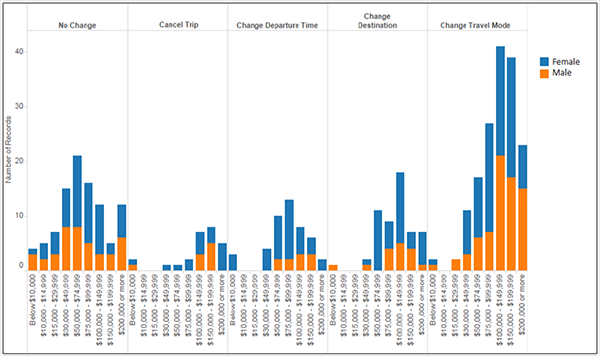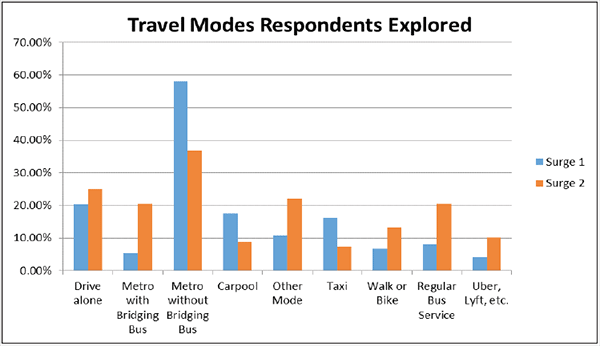You are here
UTC Research Explores Commuter Travel Changes with Metro SafeTrack Underway in Washington D.C.
Collaborative research between the University of Maryland’s National University Transportation Center (UTC) and George Mason University, a Tier 1 UTC consortium member, has resulted in a project that examines the human and system-wide impacts of the Washington Metro SafeTrack – a series of 15 major track maintenance projects that will partially shut down or significantly reduce Metro rail transit services between summer 2016 and spring 2017. Part of the research was subsequently funded by the National Science Foundation, demonstrating how UTC seed money can help researchers leverage additional funding resources to extend the value and impact of their work.
The research team is collecting a unique before-and-after travel behavior adjustment dataset by integrating mail/web-based surveys, smartphone-based surveys, vehicle probe data, transit ridership dynamics, bike share usage, and bike and pedestrian counts. The objective is to improve understanding of human behavioral responses, decision-making by travelers, and system re-equilibration after such transit system disruptions through modeling and data analysis. In addition, the multidisciplinary research team applies an integrated agent-based travel behavior (SILK) and dynamic traffic simulation (DTALite) model system to predict the regional and local traffic impact of each of the 15 SafeTrack surges, which helps travelers plan ahead. More information about the project can be found on the media landing website: http://www.eng.umd.edu/media/safetrack
Research Findings
By comparing responses from more than a thousand travel behavioral surveys, before and after each SafeTrack surge from the same group of initial Metro riders, the research team found that:
- The three most common behavior responses to the Metro service disruptions are no change to behavior, changing mode, and changing departure time (see Figure 1).
- More people chose to change modes or destinations instead of changing departure time in Surge 2 (service shutdown) compared to Surge 1 (service reduction due to continuously single tracking).
- Wealthier Metro riders are more likely to choose to drive alone, or to switch to for-hire modes such as Uber and Lyft, while lower income groups are more likely to choose regular/bridging bus services, or stick to the original travel plan despite longer transit delays.
- More than half of the riders surveyed by the team tried more than one behavioral adjustment option before choosing the most preferable one (see Figure 2).
- Many of the respondents did not end up choosing the travel option they originally stated in the pre-event survey.
This project is at the confluence of research interests and expertise of both participating UTCs, which include the behavioral and system impact of transit service disruptions due to major maintenance activities, an emerging priority for many transit operators across the United States. Both UTCs also have a strong presence in the Washington D.C. metro area. Lei Zhang, Ph.D., Director of NTC@Maryland, stressed that “This project is possible and successful because of the multi-UTC collaboration. Researchers at both UTCs contributed expertise on advanced travel behavior data collection methods and integrated transportation systems modeling tools.” Adel Sadek, Ph.D., Director of TransInfo, pointed out “this project serves as an excellent example for the type of research TransInfo is interested in.”
The research team has previously developed an integrated travel behavior and dynamic traffic assignment/simulation model system (SILK-DTALite) from prior FHWA Exploratory Advanced Research Program, SHRP2, and Maryland State Highway Administration projects that cover the entire Washington, D.C., metropolitan area. This modeling system is used to predict the regional traffic impact of individual SafeTrack projects. The predictions are for typical weekday traffic demand and conditions in the affected area(s). In most cases, the overall travel delay in the affected area due to traveler’s behavior adjustments will only increase by a very small amount (less than or around 2%). No major increase in local traffic queuing on arterial streets is observed from simulation results either. Most drivers should not worry about new gridlocks during the SafeTrack surge projects already analyzed by the team. The traffic impact is also slightly worse in the morning peak period than the afternoon peak periods. These model predictions are later verified and corroborated by observed before-and-after system performance data from the University of Maryland Center for Advanced Transportation Technologies (CATT).
About This Project UTC
The joint team includes researchers from the National Transportation Center at the University of Maryland (NTC@Maryland), and from George Mason University, one of four consortium members of the Tier 1 UTC (TransInfo) led by the University of Buffalo, State University of New York. The theme of the NTC@Maryland is “Strategic Transportation Policies, Investments and Decisions for Economic Competitiveness.” TransInfo is focused on “Big Data” and Transportation Informatics. This joint research effort has also drawn strong media interest, including coverage in the Washington Post, Washington Times, Politico, television news and radio broadcasts.

Figure 1: Travel behavior responses to safetrack transit service shutdown by income groups.

Figure 2: Alternative travel modes transit riders explored during service reduction (surge 1) and serve shutdown (surge 2).
